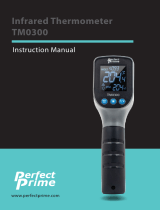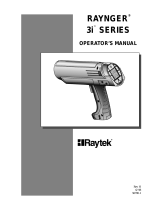Page is loading ...

Water-proof
Handheld Infrared
Thermometer
LTM-100
IMC05L01-E1
Instruction Manual
Thank you for purchasing this RKC product. In order to
achieve maximum performance and ensure proper
operation of your new instrument, carefully read all the
instructions in this manual. Please place the manual in a
convenient location for easy reference.
SEP. 2014 [IMQ00]
Relation of Distance
and Measuring Diameter
The relation between the distance and measuring diameter is as
follows. The more the distance increases, the larger area is needed.
For accurate reading, a sufficient measuring area should be
ensured.
The above measuring diameter is defined as an area which allows
capture of more than 90% of energy.
Troubleshooting
Symptoms Cause Countermeasures
No display
appears
Batteries have been
exhausted or they
are not placed
correctly.
Replace or place them correctly.
Laser beam is not
emitted or is weak.
Battery voltage is
low.
Measurement is possible. Replace
batteries when the laser marker is
necessary.
Abnormal reading Plastic lens is dirty. Clean the plastic lens referring to
the “Maintenance” section.
A heat source
nearby affects.
Shield the heat source by a
shielding plate.
Emissivity is not
selected properly.
If emissivity is unknown, refer to
“Reference” section. Also, measure
the temperature by a contact type
thermometer and select adequate
emissivity so that temperature of
this instrument becomes equivalent
to that of the contact type
thermometer.
Measuring target
area is too small.
Check the target area and keep a
sufficient area for measurement.
Unstable reading Unit is affected by a
rapid temperature
change.
Leave the unit for stabilizing its
temperature and measure.
No reading
appears but
display is ‘OL.’
Out of measuring
temperature range.
Check the target to be measured.
Notice
This manual assumes that the reader has a fundamental
knowledge of the principles of electricity, process control,
computer technology and communications.
The figures, diagrams and numeric values used in this manual
are only for purpose of illustration.
RKC is not responsible for any damage or injury that is caused
as a result of using this instrument, instrument failure or indirect
damage.
RKC is not responsible for any damage and/or injury resulting
from the use of instruments made by imitating this instrument.
Periodic maintenance is required for safe and proper operation
of this instrument. Some components have a limited service life,
or characteristics that change over time.
Every effort has been made to ensure accuracy of all information
contained herein. RKC makes no warranty expressed or implied,
with respect to the accuracy of the information. The information
in this manual is subject to change without prior notice.
No portion of this document may be reprinted, modified, copied,
transmitted, digitized, stored, processed or retrieved through any
mechanical, electronic, optical or other means without prior
written approval from RKC.
Company names and product names used in this manual are the
trademarks or registered trademarks of the respective
companies.
All Rights Reserved, Copyright 2014, RKC INSTRUMENT INC.
Specifications
Type
Measuring Range
Display Resolution
Measuring Accuracy
LTM-100
40 to 300C
0.5C. 1C for below 20C and over 100C.
When the ambient temperature is 252C and the emissivity
() is 1,
0 to 300C: bigger value of either of 1% of the measured
value 1dg’t or 2C 1dg’t.
0 to 30C: 3C 1dg’t
below 30C: 5C 1dg’t
Repeatability
within 1C 1dg’t
Response 1sec (90% response)
Measuring Diameter
45mm/500mm (Optical sensitivity:90%)
Emissivity Settings
Before shipment: 0.95. The value can be altered between 0.8
and 1.0 with the slide switch at the lower part of the battery
compartment (by 0.05 steps).
Collimation Laser beam (650nm 1mW JIS class2) specifies the center.
Water -Proof Property IP67
Auto Power Off
If no key is pressed for 30 seconds, the power is shut off
automatically.
Shock Proof Property
This instrument or its function/performance will not be
damaged even if it is dropped on the vinyl tile floor from 1
meter high.
Operating Temperature
0 to 50C
Operating Humidity 90% rH and below (no condensation)
Storage Temperature
20 to 55C (no condensation) (Note): In the case of
long-term storage, the batteries should be removed.
Battery 2 AAA alkali cell batteries
Battery Life Approximately 10 hours for continuous use
Housing material ABS (antibacterial)
Dimension
120 60 54mm (Maximum value for each direction)
Weight Approx. 123g
Accessories 2 AAA alkaline cell batteries, instruction manual, strap
Approved Standard
Consumer product safety law: portable laser applied
instrument (PS/C mark)
CE marking: EN61326-1/Class B
FCC This device complies with part 15 of the FCC Rules.
Operation is subject to the following two conditions:
(1) This device may not cause harmful interference
and (2) this device must accept any interference
received, including interference that may cause
undesired operation.
Maintenance
Measuring Window
The measuring window applies a waterproof structure (IP67).
If water-soluble stains adhere to the window, wash the measuring
window with the tap water. Dry the measuring window well after
washing. Please note that measurement with the measuring window
wet will cause inaccurate readings. If oil-soluble stains adhere to the
measuring window, wipe it with a cloth dipped in the diluted neutral
detergent and rinse it.
Note
Do not use chemical agents such as thinner, benzin or alcohol since
these may cause a crack or fog on the surface of the measuring
window, and consequently it may change the infrared radiation
transmittance of the plastic lens.
Plastic Lens
Dust, stains and scratches on the measuring window cause
inaccurate readings. Wipe such stains off with a soft cloth or cotton
bud for camera or glasses. To get rid of tough stains, remove the top
hood (rubber) by drawing it, wipe the lens with a cloth dipped in the
diluted neutral detergent and rinse it. After getting rid of the stains,
put the top hood back to the previous place by putting the projection
along its edge and the ones on the case together. After putting it,
make sure of fitting it to the correct position.
Caution
LTM-100 is one of the portable
laser applied instruments which
are regulated by the consumer
product safety law.
Do not look into the laser beam.
Do not aim the laser beam at
human beings.
Keep the instrument out of
children’s reach.
Please follow the precautions below for use to keep
the instrument’s functions proper and to enable
accurate measurement.
Safety Precautions
Do not contact this product with a measuring object.
This is a contactless thermometer. Contact with a hot section
may cause unrepairable damages or inaccurate readings.
Do not damage the measuring window (plastic lens).
Do not contact a hard object with the measuring window.
Do not let a foreign object penetrate the measuring window, or
drop a hard object on the measuring window.
Although this instrument applies a shockproof structure, do not
give an excessive shock to the instrument.
Do not bring the instrument closer to an electrostatic object.
Emissivity of this instrument can be selected (0.8 to 1.0). When
the emissivity setting is different from that of a measuring
object, an inaccurate reading will occur.
The sudden changes of the ambient temperature will cause
inaccurate readings. Wait a while to let the temperature of the
instrument stabilize, and then measure.
Remove batteries from the instrument, if the instrument is not in
use for a long period or is put in storage.
Environmental Precautions
Do not use or store the instrument
in a location where the instrument
is exposed to the direct sunlight,
dust, lampblack and corrosive
gas, or where the temperature
and/or humidity is high. Otherwise
the measuring window gets soiled
or deteriorated, which causes
inaccurate readings.
As this instrument applies a waterproof structure (IP67), a slight
wetting will not damage the instrument. When the plastic lens is
wet, however, wipe the lens carefully so as not to scratch it as
the wetting condition will cause inaccurate readings.
Keep the instrument away from an object which radiates a
strong electromagnetic wave.
®
RKC INSTRUMENT INC.
HEADQUARTERS:16-6, KUGAHARA 5-CHOME, OHTA-KU
TOKYO 146-8515 JAPAN
PHONE: 03-3751-9799 (+81 3 3751 9799)
E-mail: [email protected]
FAX: 03-3751-8585 (+81 3 3751 8585)
Website: htt
p
://www.rkcinst.com/
®
RKC INSTRUMENT INC.

Usage and Part Names
Measurement Display
Aim the measuring window at the measuring target, and press the
MEASURE key. Holding down the MEASURE key, confirm if the
laser beam irradiates the measuring position properly. Adjust the
position, if the laser beam does not irradiate the measuring position
properly. During holding down the MEASURE key, measuring
continues. When the MEASURE key is released, the measured
value is hold for about 30 seconds, and then the power is shut off
with the auto power off function.
If the measuring window is aimed at a new target and the
MEASURE key is pressed while the measured value is being hold,
the temperature of the new target will be measured. When the
MEASURE key is released, the newly measured temperature will be
hold.
Settings
Normally only the object emissivity is selectable. The emissivity is set at
0.95 at the factory. The emissivity is displayed during measurement
(except for emissivity 0.95. When nothing appears on the display, it
means that the emissivity is 0.95.) Five variations of emissivity ranging
from 0.8 to 1.0 can be set per 0.05 steps.
The emissivity can be altered by setting the 3 digits (2nd, 3rd and 4th
digits) of the 4-digit slide switch in the lower part of the battery
compartment. The setting mode of the slide switch is displayed below
the battery part. Remove the batteries, and set as required according to
the displayed setting mode.
If necessary, the measurement unit can be switched to Fahrenheit (F)
(with the first digit of the 4-digit slide switch.)
Setting Emissivity (Reference)
Quantity of infrared radiation irradiated from objects depends on the
objects’ material, surface conditions, measuring temperatures and so
on. The table below shows emissivity of some objects. Please note that
these values are just for reference. Please also refer to the estimated
emissivity using the separately sold black body tape.
Emissivity of Objects
Material Emissivity Material Emissivity
Water, Ice 0.98 Cloth, Fabric (colored) 0.95
Soil 0.92 to 0.96 Leather, Far 0.96
Concrete (wet) 0.96 to 0.98 Human Skin 0.99
Concrete (dry) 0.91 to 0.95 Vegetable, Fruit 0.98
Ceramics 0.85 to 0.95 Dough 0.98
Stone, Asbestos 0.92 Meat 0.98
Plastics 0.90 to 0.95 Copper Oxide 0.5 to 0.6
Rubber (black) 0.95 Ferric Oxide 0.7 to 0.8
Wood 0.98 Painted Surface 0.8
Paper 0.92 Tile 0.8
Estimated Emissivity Using the Black Body
Tape
If a measuring object accepts sticking of adhesive tapes, stick a piece
of the black body tape (emissivity: 0.94) to the object, and measure the
temperature after setting the emissivity to 0.95.
Laser Mark
Lighting during measuring
Displays
measured value
Low Battery Symbol
Displays
measurement unit
Displays emissivity
(except emissivity 0.95)
Display
Blinking during measuring
Lighting during holding
Battery
(1) Installing Batteries
Loose the screw at the lower part of the
battery cover, pressing the battery
compartment cover as shown and remove
it. Install batteries positioning the negative
and positive poles properly as shown inside
the compartment. And bolt up the screw,
put the cover back.
Note:
If the battery cover does not fit tightly, water-proof property will be deteriorated,
or the performance will be deteriorated due to water penetration in the unit.
Don’t bolt up the screw too tightly, as putting the battery compartment cover.
(2) Replacing Batteries
Residual quantity of the batteries is displayed on the low battery symbol in the
display part. When the low battery symbol becomes the batteries have
been exhausted. Replace the batteries with new batteries.
Note:
When replacing batteries, do replace 2 batteries at the same time.
= 0.80
C/F switch
0: C 1: F
/

